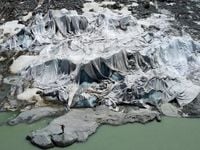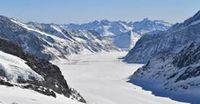Switzerland, long celebrated for its breathtaking alpine vistas and iconic glaciers, is facing a sobering reality: its glaciers are melting at an unprecedented rate. According to a series of reports published on October 2, 2025, by the Swiss glacier monitoring group GLAMOS and the Swiss Academy of Sciences, the nation’s glaciers have suffered a 3 percent reduction in total volume this year alone—marking the fourth-largest annual decline on record. This dramatic loss, experts warn, is yet another stark indicator of the accelerating impacts of global warming on Europe’s mountainous heart.
“Glacial melting in Switzerland was once again enormous in 2025,” the scientists stated, as reported by Business Standard. A winter marked by scant snowfall, followed by searing heat waves in June and August, led to the early depletion of snow reserves—some as early as the first half of July. The result? Glaciers began their seasonal melt sooner than ever before, with ice masses below 3,000 meters above sea level suffering the most severe losses. Some glaciers lost more than two meters of ice thickness, while others still saw reductions of around a meter, according to the Swiss Commission for Cryosphere Observation (SCC) of the Swiss Academy of Sciences.
Switzerland is home to nearly 1,400 glaciers, more than any other European country. But over the past decade, the nation has lost a staggering one-quarter of its total glacier volume. More than 1,000 small glaciers have already vanished, a stark reminder of the relentless march of climate change. The 2025 shrinkage is surpassed only by the catastrophic losses of 2022, 2023, and 2003, underscoring a troubling trend that shows no signs of abating.
The causes behind this accelerated retreat are clear. “Glaciers are clearly retreating because of anthropogenic global warming,” said Matthias Huss, head of GLAMOS and a glaciologist at Zurich’s ETHZ university, as quoted by The Economic Times. “This is the main cause for the acceleration we are seeing in the last two years.” The combination of a winter with low snow depth and the second-warmest June on record, followed by intense August heat, created a perfect storm for glacier melt. Snow reserves, which typically last deep into the summer, were depleted by early July, leaving glaciers exposed to the full brunt of the summer sun.
The implications of this rapid glacial retreat are far-reaching. Switzerland’s glaciers are not just symbols of natural beauty—they are vital to the nation’s hydropower generation, tourism, farming, and water resources. As the glaciers shrink, so too does the country’s ability to generate clean energy and support agriculture, while communities that rely on glacier-fed rivers face increasing uncertainty. The repercussions extend beyond Swiss borders, affecting water resources in many European regions that depend on the steady flow from the Alps.
Tourism, a cornerstone of the Swiss economy, is also feeling the pinch. Visitors from around the world have long flocked to Switzerland to marvel at its icy giants. But as glaciers recede and landscapes change, the allure of these once-eternal ice fields is fading. The loss of over 1,000 small glaciers is a sobering statistic, one that resonates with both locals and tourists alike.
Perhaps most concerning, however, are the geological consequences of this glacial retreat. As ice masses disappear, the stability of the mountains themselves is compromised. “The continuous diminishing of glaciers also contributes to the destabilisation of mountains. This can lead to catastrophic events such as in the Lotschental valley, where an avalanche of rock and ice buried the village of Blatten,” Matthias Huss warned, according to IANS and Devdiscourse. In May 2025, a colossal rock and ice fall from a glacier buried much of the southern village of Blatten, serving as a grim illustration of the dangers posed by a rapidly changing alpine environment.
Swiss authorities are not taking these risks lightly. They have been on heightened alert for landscape changes, closely monitoring evolving terrain and environmental conditions to mitigate hazards. The shifting ground and unstable mountains are not just theoretical threats—they are immediate concerns for communities living in the shadow of the Alps. The government’s vigilance is a testament to the seriousness of the situation and the need for adaptive strategies to protect both people and the environment.
The scientific community is united in its assessment of the situation. The GLAMOS and SCC reports leave little doubt about the role of human activity in driving these changes. The evidence points overwhelmingly to anthropogenic climate change as the primary culprit. The pattern of glacier loss in recent years—punctuated by record-setting shrinkages in 2022, 2023, 2003, and now 2025—reflects a climate system under increasing stress from greenhouse gas emissions and rising global temperatures.
Even the International Year of Glaciers’ Preservation, designated for 2025, could not stem the tide. Despite global attention and renewed calls for action, Switzerland’s glaciers continued their retreat, highlighting the immense challenge of reversing or even slowing the effects of climate change. “The findings serve as a vivid reminder that the delicate balance of nature is under siege, and the race to protect these frozen giants has never been more urgent,” noted the SCC in its summary of this year’s data.
The loss of glacier mass is not just a Swiss problem—it is a European and global concern. As glaciers shrink, so too does the continent’s natural water reservoir, threatening everything from electricity production to food security. The Alps, often referred to as the “water towers of Europe,” play a crucial role in regulating river flows and supporting life far beyond Switzerland’s borders.
Looking ahead, the outlook remains grim unless decisive action is taken. Scientists and policymakers alike are calling for stronger measures to curb greenhouse gas emissions and adapt to the new realities of a warming world. The story of Switzerland’s glaciers is a microcosm of a global crisis—one that demands urgent attention and collective effort.
As the sun sets over the Alps, the once-mighty glaciers stand as both a warning and a call to action. Their retreat is a testament to the profound changes sweeping our planet, and a reminder that the time to act is now, before more of these icy sentinels disappear forever.


